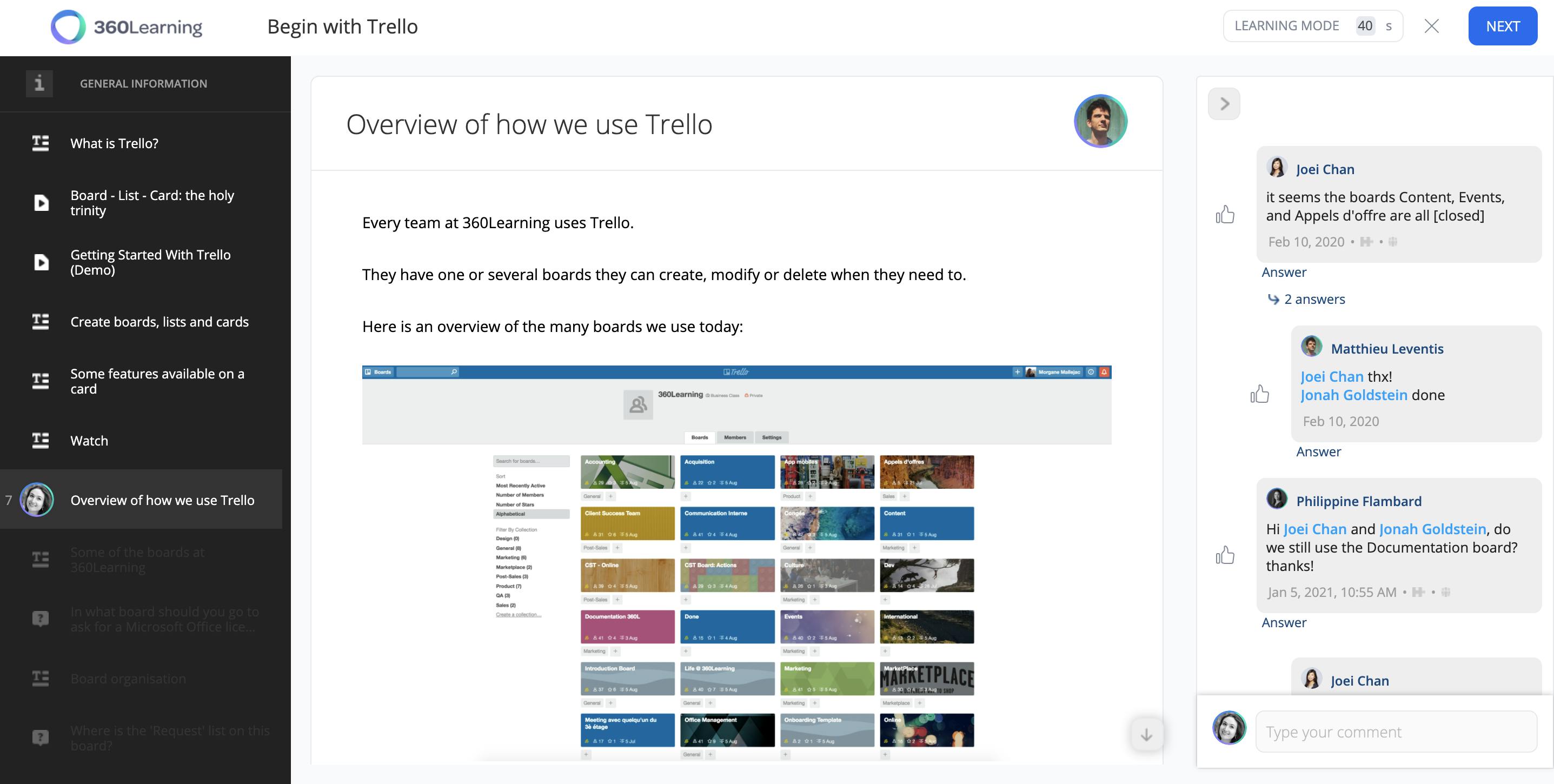
Why Collaboration Skills Offer a Major Competitive Advantage (Plus 10 Ways to Unleash Them)
Everyone on your team knows something someone else doesn’t, whether through current experience with your company or in another life with another employer. But, if your employees lack collaboration skills, you’re doomed to an office of siloed institutional knowledge.
And worse—this lack of collaboration and communication could cost you your employees. In 2019, 63% of employees felt the urge to quit their job over poor communication. This number wouldn’t be nearly as high if companies prioritized clear communication, collaborative tools, opportunities to work together, and a sense of community.
Fostering collaborative skills isn’t just about avoiding the bad. It’s about building a happier, more productive workplace that outpaces the competition and draws in top talent.
Why build collaboration skills?
Collaboration skills help teams get work done faster, better, and with less fuss. And when you build those skills across all levels of your business, you're setting yourself up to outpace the competition.
Collaboration makes you competitive
Research shows that education alone won’t make your team productive. But, creating a culture of collaboration, in which teams know how to effectively work together, will. In the end, your company can become more competitive in your market. There are a few reasons this is the case.
Collaboration helps spread institutional knowledge. Institutional knowledge is unique to your company (and one of its biggest assets). Unlike many skill-based forms of knowledge, institutional knowledge takes time to amass because it’s derived from your own discoveries as your business grows and evolves. But, without proper collaboration, that information becomes siloed and loses much of its value.
If someone quits without sharing their institutional knowledge, that knowledge leaves with them. And if someone knows a better way to do something and doesn’t share it, everyone else continues operating inefficiently. A properly collaborative environment will lead to a place where institutional knowledge is created by your entire workforce and shared with all, resulting in a more effective team.
Antonio M. Battro, a physician and researcher, found the learner and teacher excel when both parties are engaged. This engagement goes beyond a learning environment. If you’re building an engaging workplace, you can create a team that’s learning from one another and ready to excel in their own fields. With employee engagement hanging around 34%, driving engagement is a top priority for most businesses. (This means it should probably be a top priority for you, too.)
There’s a good chance your competitors share these beliefs and are investing in collaboration. By not investing in collaboration skills, you’re immediately putting yourself at a disadvantage.
Professionals want collaboration
Collaboration makes your company more competitive, but the benefits don’t stop there. Professionals are clamoring for more collaborative environments. When employers fail to deliver, the result is a less engaged workforce that’s more likely to quit. But, this is only scratching the surface of the employee demand for collaboration:
- Two of the top three areas where employers want more—soft skills and team effectiveness—have collaboration at their core. Between employees wanting more collaboration and employers making it a focus, your company could miss out on top talent by neglecting collaboration.
- Collaboration gives everyone a chance to contribute by using their own strength. Not only does this result in a stronger end result, it also drives engagement up nearly six times and creates a workforce that’s more committed to your company.
Companies largely rise and fall on account of the employees they have—or don’t have—supporting them. A focus on collaboration skills and a more collaborative workplace can help you land talented employees, keep them engaged, and keep them around.
Related: Onboarding, Ramp-Up, and Beyond: What You Can Expect From the 360Learner Journey
10 ways to foster collaboration skills in your workplace
You can’t leave it up to employees to build the collaboration skills they need to drive a collaborative workplace. You need to be intentional about building these skills in your business. There are several ways you can directly and indirectly build collaboration skills, from creating an environment that’s conducive to collaboration to directly training on such skills.
1. Invest in the right tech
In the pre-COVID era, we could swing by a coworker’s desk to share ideas and brainstorm. Now, with many companies working remotely, we need tools to enable and strengthen collaboration. In fact, 83% of professionals say they use technology to collaborate.
Tools that support collaboration, like Trello, Miro, or of course, 360Learning, can make collaboration easier and incredibly accessible. Collaboration tools allow your team to simultaneously work on projects, communicate, and share updates in real-time. This removes the barrier of remote work, giving your team the ability to digitally “stop by a coworker’s desk.”
2. Facilitate cross-team collaboration
Cross-team collaboration allows people from other departments to work together on projects. This can strengthen communication skills, lead to peer learning through observing different trains of thought, and come with the bonus of building camaraderie.
To ensure cross-team collaboration happens, give people the opportunity to work across teams. Instead of keeping people in silos, open projects up to other teams and pair people up on tasks. Even something as simple as brainstorming across teams can result in stronger, closer ties.
3. Assign projects outside of comfort zones
Standard cross-team collaboration is great for helping others work as a unit, but intentionally assigning projects outside of one’s comfort zone also has unique benefits.
Assign projects outside of an employee’s comfort zone, so they have to learn from those who know the subject area. If someone usually works with the product team, give them a project that involves marketing or sales. This will not only help employees work on communicating with those from different backgrounds or with differing perspectives, it will also help employees work on active listening and humility.
Assigning projects outside of comfort zones also results in a more coherent knowledge of the company, as you’re once again breaking down silos.
4. Emphasize clear communication
Few things spoil collaboration like poor communication and unclear instructions. Clear communication helps prevent this potential friction during collaboration.
Start by creating guidelines around internal and external communications—practices around how long an email should be, how to create agendas for meetings, succinct reporting techniques, and so on. These guidelines will help new hires and established employees alike build healthy, clear communication habits.
Keep in mind that the right tools will also make effective communication easier. For example, we use Trello to comment on projects, communicate clearly and quickly, and avoid sending emails when a simple Trello comment would do. We even have a course that teaches our team how to most effectively use Trello.

Along those lines, we have a whole course in our onboarding about using the Pyramid Principle (you can see a screenshot of this below). We explain how this way of communicating—orally or in any kind of writing—helps save time, keep messages clear, and creates better team play.

5. Run fun team-building activities
Work is important, but you know what they say about all work and no play. Take time off of work and allow your team to enjoy fun team-building activities.
If you’re remote, have your team engage in online scavenger hunts, puzzle-solving, or even quiz tournaments. There are even virtual escape rooms, which build collaboration skills like clear communication and cross-team collaboration.
Once it’s safe to gather, set aside time to go on a team-building retreat. Besides being a great excuse to go to a fun location, team-building retreats allow your team to exercise communication and collaboration by engaging in non-work-related challenges. (Escape rooms are always fun and require absolute collaboration.) Here's a group activity we did virtually around Kintsugi pottery:

6. Build a culture of honesty and transparency
Collaboration requires a high degree of trust—and trust starts from the top. Encourage your employees to be honest and transparent (all the while practicing what you preach).
Make it a point to encourage honesty and transparency at every level within your company. These two characteristics play a big part in successful collaboration. Helping others is a key theme of collaboration, and without transparency, it’s difficult to know when someone needs help. By encouraging transparency and even modeling it yourself and amongst other members of the leadership team, you’re showing others it’s okay to ask for help.
7. Set clear expectations
Be clear when you’re outlining expectations for particular roles or projects. Without clear expectations, your team will be unsure what to focus on and will likely waste time and energy doing work that misses the mark. Wasted time and energy benefits no one and could lead to frustration within your team.
Clearly outline what it is you want from your team, both within their role and on whatever task they’re working on. Consider setting Objectives and Key Results (OKRs) for each project and person, as these offer a tangible and clear measurement of success for your team to work toward.
8. Work on conflict management and resolution
During collaboration, it’s only natural that conflict arises from time to time. This conflict could be a simple disagreement or something larger. Conflict management and conflict resolution are vital for avoiding unnecessary conflict and navigating conflict as it arises.
Train your entire company on conflict resolution and conflict management to ensure your employees know how to carry themselves and peacefully reach agreements. This training can take place as an online course that utilizes scenarios to show conflict management and resolution playing out. You can also role-play various scenarios, but be warned that’s something a lot of people on your team may not be comfortable doing.
9. Model collaborative behavior
It’s easy to talk about policies and ideal behaviors, but it’s another matter to act on them. Lead by example and have your management and leadership teams embody the collaboration behavior and skills you want your team to adopt.
Create policies and opportunities that allow your management and leadership teams to showcase collaboration skills and behavior. This will help your team see the value in collaboration and make it known that collaboration is not just lip service—it’s something your entire company believes in.
Your management can lead cross-team collaborative projects, stand-in for one another during absences, and give presentations to teams other than their own.
10. Celebrate collaborative victories
Reinforce the collaboration you want to see by making it a point to celebrate collaborative skills and victories—big and small.
Did a team effort result in a major project completion? Did two people from different departments come up with a creative solution to a problem? Celebrate these victories and show your company that collaborative victories are worth shouting from the rooftops.
You can celebrate these victories via email, during meetings, or within any of the collaborative tools you’ll soon be using. The important thing is that your team realizes their efforts are appreciated.
Collaborative Learning leads to collaborative work
A Collaborative Learning environment is one in which knowledge and ideas are exchanged freely, and information is no longer siloed. With your company’s newly gained collaboration skills, you have the tools to embrace a Collaborative Learning environment, freely share knowledge, and lift up your entire team as a result.
Download your free copy of our Collaborative Learning eBook today and get a jump-start on breaking down silos and building a more knowledgeable team.


